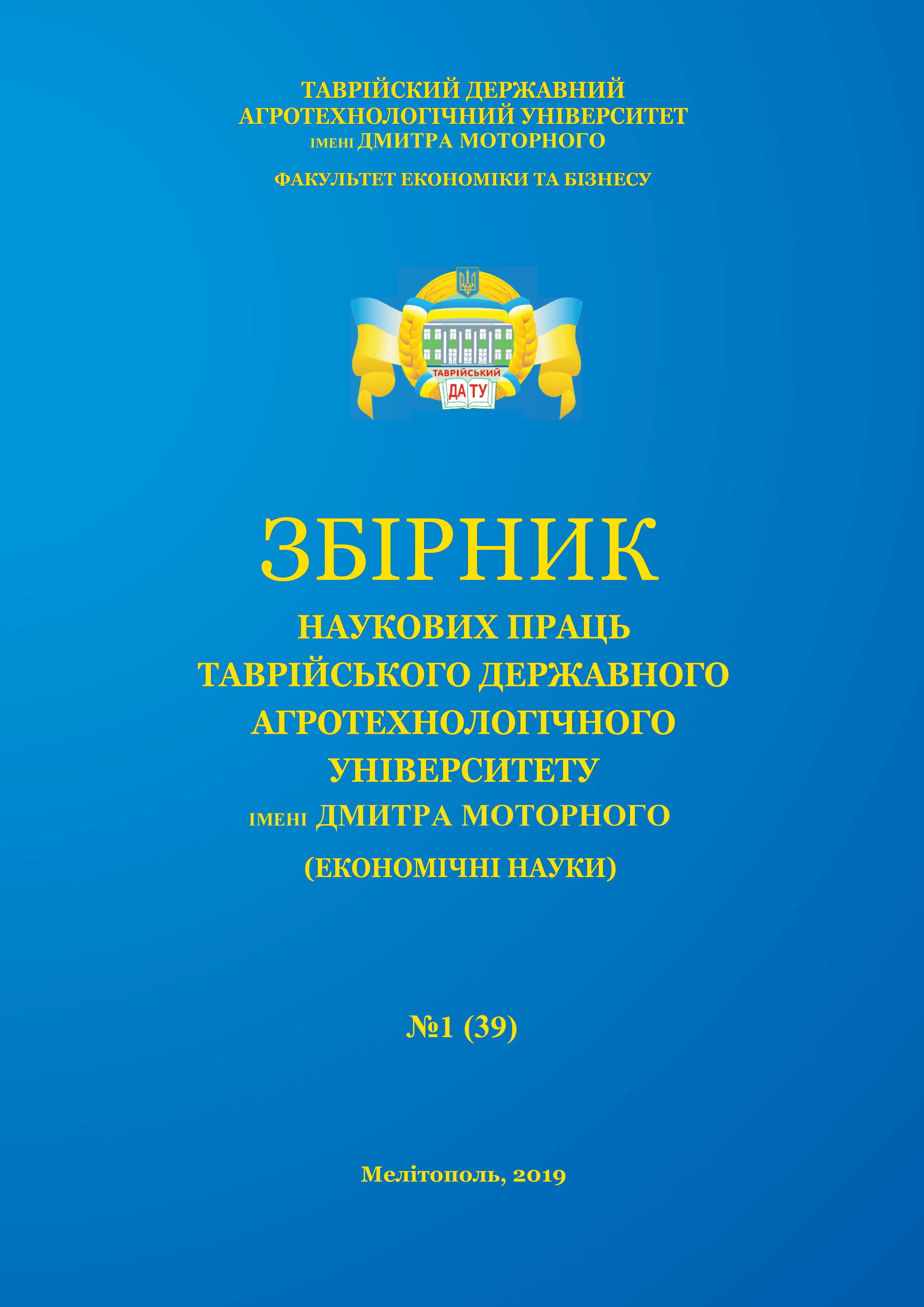АГРОПАРКИ ПОВНОГО ЦИКЛУ ВИРОБНИЦТВА В КОНТЕКСТІ ІННОВАЦІЙНОГО РОЗВИТКУ ПІВДЕННОГО РЕГІОНУ УКРАЇНИ
Ключові слова:
повний цикл виробництва, інноваційний розвиток регіону, кластеризація., інновація, модель, Агропарк, кластерний підхід.
Анотація
Анотація. У статті проведено дослідження організаційно-економічних механізмів створення Агропарку повного циклу виробництва, який допоможе Південному регіону у інноваційному розвитку. Використання кластерного підходу дає змогу визначити однорідні групи підприємств, для кожного з яких запропоновано уніфіковані стратегії інноваційно-економічних перетворень. Уперше запропоновано інноваційну модель Агропарку повного циклу виробництва Південного регіону на основі кластерного підходу.
Посилання
1. Федулова Л. І. Інноваційність економіки ЄС та України: напрями скорочення розриву. Economic Annals-XXI. 2016. №
156(1–2). С. 22–25. URL: http://dx.doi.org/10.21003/ea.V156-0005
2. Адвокатова Н.О. Стратегічні орієнтири і прогнозування розвитку галузі овочівництва. Сучасні тренди і перспективи
розвитку овочівництва у Херсонській області: колективна монографія / за ред. Н.С. Танклевської. Херсон: Видавничий дім
«Гельветика», 2019. С.110-133.
3. Шарко М.В. Иерархическая кластеризация производственных объектов. Вісник Київського національного торгове-
льно-економічного університету. К.: Київський національний торговельно-економічний університет. 2013. № 3. С. 114-128.
4. Танклевська Н.С., Карнаушенко А.С. Розвиток фінансування діяльності аграрних підприємств: монографія. Херсон:
Айлант, 2015. 184 с.
5. Food and Agricultural Organization (FAO). FAOSTAT database, сompare data. Version current 2019. URL:
http://www.fao.org/faostat/en/#compare.
6. Юрчишин В. В. Сільські території як системоутворюючі фактори розвитку аграрного сектора економіки. Економіка
АПК. 2005. № 3. С. 3–10.
7. Маслак О., Маслак Н., Гужвенко С. Передумови розвитку малого підприємництва в сільській місцевості. Agricultural
and Resource Economics: International Scientific E-Journal. 2018. Vol. 4. No. 4. Pp. 113–129. URL: http://arejournal.com.
8. Малік М. Й., Пулім В. А. Концептуальні засади розвитку сільських територій. URL: http://vadyba.asu.lt/8/156.pdf.
9. Попович В. В., Колмогорова І. В. Особливості становлення та розвитку сільських територій в Україні. Ефективна
економіка. 2012. № 12. URL: http://www.economy.nayka.com.ua/?op=1&z=3294.
10. Присяжнюк О., Плотнікова М. Удосконалення моделі управління аграрними проектами. Agricultural and Resource
Economics: International Scientific E-Journal. 2017. Vol. 3. No. 1. pp. 164–172. URL: http://are-journal.com.
11. Чемерис В., Душка В., Максим В., Соломонко Д. Бізнес-модель розвитку сільських територій України. Agricultural
and Resource Economics: International Scientific E-Journal. 2019. Vol. 5. No. 1. Pp. 154–176. URL: http://are-journal.com.
12. Кузьмін О., Жежуха В. Кластери як чинник інноваційного розвитку підприємств і територіальних утворень. Економіка
України. 2009. №2. С. 14–23.
13. Babenko V. О. Modeling of factors influencing innovation activities of agricultural enterprises of Ukraine. Scientific Bulletin
of Polissia. 2017. Vol. 2. Is. 1(9). Pp. 115–121. URL: http://dx.doi.org/10.25140/2410-9576-2017-2-1(9)-115-121
14. Chesbrough H. W. Open Business Models: How to Thrive in the New Innovation Landscape. Boston, MA: Harvard Business
School Press, 2006. 224 p.
15. Jansen W. New Business Models for the Knowledge Economy. London, 2007. 159 p. URL:
https://doi.org/10.4324/9781351152723.
16. Teece D. J. Business models and dynamic capabilities. Long Range Planning. 2018. Vol. 51. Is. 1. Pp. 40–49.
https://doi.org/10.1016/j.lrp.2017.06.007.
17. Про фермерське господарство: Закон України від 14.06.2003 р. № 973-IV (зі змінами). URL:
https://zakon.rada.gov.ua/laws/show/973-15.
18. Про державну підтримку сільського господарства України: Закон України від 24.06.2004 р. № 1877-IV (зі змінами).
URL: https://zakon.rada.gov.ua/laws/show/1877-15.
19. У 2016 році розпочато створення 6 агро-рекреаційних кластерів. Міністерство аграрної політики і продовольства.
URL: http://minagro.gov.ua/node/22957.
20. FAO (2017), The State of Food and Agriculture. Leveraging food systems for inclusive rural transformation. URL:
http://www.fao.org/3/a-I7658e.pdf.
21. Vasylieva, N. K. (2016), Cluster models of households’ agrarian production development. Economic Annals-XXI, vol. 158,
is. 3-4(2), pp. 13–16. URL: http://dx.doi.org/10.21003/ea.V158-03.
156(1–2). С. 22–25. URL: http://dx.doi.org/10.21003/ea.V156-0005
2. Адвокатова Н.О. Стратегічні орієнтири і прогнозування розвитку галузі овочівництва. Сучасні тренди і перспективи
розвитку овочівництва у Херсонській області: колективна монографія / за ред. Н.С. Танклевської. Херсон: Видавничий дім
«Гельветика», 2019. С.110-133.
3. Шарко М.В. Иерархическая кластеризация производственных объектов. Вісник Київського національного торгове-
льно-економічного університету. К.: Київський національний торговельно-економічний університет. 2013. № 3. С. 114-128.
4. Танклевська Н.С., Карнаушенко А.С. Розвиток фінансування діяльності аграрних підприємств: монографія. Херсон:
Айлант, 2015. 184 с.
5. Food and Agricultural Organization (FAO). FAOSTAT database, сompare data. Version current 2019. URL:
http://www.fao.org/faostat/en/#compare.
6. Юрчишин В. В. Сільські території як системоутворюючі фактори розвитку аграрного сектора економіки. Економіка
АПК. 2005. № 3. С. 3–10.
7. Маслак О., Маслак Н., Гужвенко С. Передумови розвитку малого підприємництва в сільській місцевості. Agricultural
and Resource Economics: International Scientific E-Journal. 2018. Vol. 4. No. 4. Pp. 113–129. URL: http://arejournal.com.
8. Малік М. Й., Пулім В. А. Концептуальні засади розвитку сільських територій. URL: http://vadyba.asu.lt/8/156.pdf.
9. Попович В. В., Колмогорова І. В. Особливості становлення та розвитку сільських територій в Україні. Ефективна
економіка. 2012. № 12. URL: http://www.economy.nayka.com.ua/?op=1&z=3294.
10. Присяжнюк О., Плотнікова М. Удосконалення моделі управління аграрними проектами. Agricultural and Resource
Economics: International Scientific E-Journal. 2017. Vol. 3. No. 1. pp. 164–172. URL: http://are-journal.com.
11. Чемерис В., Душка В., Максим В., Соломонко Д. Бізнес-модель розвитку сільських територій України. Agricultural
and Resource Economics: International Scientific E-Journal. 2019. Vol. 5. No. 1. Pp. 154–176. URL: http://are-journal.com.
12. Кузьмін О., Жежуха В. Кластери як чинник інноваційного розвитку підприємств і територіальних утворень. Економіка
України. 2009. №2. С. 14–23.
13. Babenko V. О. Modeling of factors influencing innovation activities of agricultural enterprises of Ukraine. Scientific Bulletin
of Polissia. 2017. Vol. 2. Is. 1(9). Pp. 115–121. URL: http://dx.doi.org/10.25140/2410-9576-2017-2-1(9)-115-121
14. Chesbrough H. W. Open Business Models: How to Thrive in the New Innovation Landscape. Boston, MA: Harvard Business
School Press, 2006. 224 p.
15. Jansen W. New Business Models for the Knowledge Economy. London, 2007. 159 p. URL:
https://doi.org/10.4324/9781351152723.
16. Teece D. J. Business models and dynamic capabilities. Long Range Planning. 2018. Vol. 51. Is. 1. Pp. 40–49.
https://doi.org/10.1016/j.lrp.2017.06.007.
17. Про фермерське господарство: Закон України від 14.06.2003 р. № 973-IV (зі змінами). URL:
https://zakon.rada.gov.ua/laws/show/973-15.
18. Про державну підтримку сільського господарства України: Закон України від 24.06.2004 р. № 1877-IV (зі змінами).
URL: https://zakon.rada.gov.ua/laws/show/1877-15.
19. У 2016 році розпочато створення 6 агро-рекреаційних кластерів. Міністерство аграрної політики і продовольства.
URL: http://minagro.gov.ua/node/22957.
20. FAO (2017), The State of Food and Agriculture. Leveraging food systems for inclusive rural transformation. URL:
http://www.fao.org/3/a-I7658e.pdf.
21. Vasylieva, N. K. (2016), Cluster models of households’ agrarian production development. Economic Annals-XXI, vol. 158,
is. 3-4(2), pp. 13–16. URL: http://dx.doi.org/10.21003/ea.V158-03.
Опубліковано
2019-09-11

